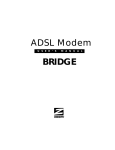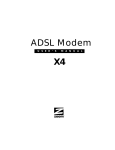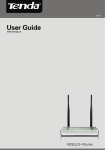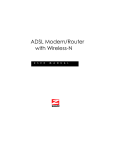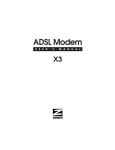Download ADSL Modem - CCS (Leeds)
Transcript
ADSL Modem U S E R ’ S M A N U A L X5 NOTICE This document contains proprietary information protected by copyright, and this Manual and all the accompanying hardware, software, and documentation are copyrighted. No part of this document may be photocopied or reproduced by mechanical, electronic, or other means in any form. The manufacturer does not warrant that the hardware will work properly in all environments and applications, and makes no warranty or representation, either expressed or implied, with respect to the quality, performance, merchantability, or fitness for a particular purpose of the software or documentation. The manufacturer reserves the right to make changes to the hardware, software, and documentation without obligation to notify any person or organization of the revision or change. All brand and product names are the trademarks of their respective owners. © Copyright 2004 All rights reserved. Contents 1 INSTALLATION ............................................................. 4 1.1 IMPORTANT! BEFORE YOU BEGIN .......................................... 4 1.2 PACKAGE CONTENTS .......................................................... 4 1.3 QUICK START INSTRUCTIONS ............................................... 5 1.4 USING PHONE FILTERS ......................................................14 1.5 IF YOU NEED HELP...........................................................15 2 ADVANCED SETUP OPTIONS....................................... 16 2.1 HOW TO USE THE ADVANCED OPTIONS .................................16 2.2 WAN SETTINGS ..............................................................17 2.3 LAN SETTINGS................................................................22 2.4 NAT FIREWALL ...............................................................23 2.5 VIRTUAL SERVER (PORT FORWARDING).................................24 2.6 DMZ ............................................................................27 2.7 DNS ............................................................................30 2.8 ADSL CONFIGURATION .....................................................31 2.9 ROUTE TABLE .................................................................32 2.10 MISCELLANEOUS ............................................................34 3 SYSTEM ADMINISTRATION ........................................ 36 3.1 MONITORING SYSTEM STATUS ............................................36 3.2 MONITORING ADSL STATUS ..............................................37 3.3 PERFORMING SYSTEM ADMINISTRATION TASKS........................39 3.4 RESETTING THE UNIT TO ITS DEFAULT SETTINGS.....................40 3.5 UPDATING THE UNIT’S FIRMWARE ........................................41 4 REMOVING THE X5 MODEM........................................ 42 APPENDIX A DSL INTERNET SETTINGS TABLES ................. 43 APPENDIX B FRONT AND BACK PANEL DESCRIPTIONS ....... 45 APPENDIX C ONLINE GAMING AND THE X5 ....................... 46 APPENDIX D MACINTOSH AND LINUX USERS: CONFIGURING TCP/IP SETTINGS.............................................................. 49 APPENDIX E TROUBLESHOOTING..................................... 54 APPENDIX F REGULATORY INFORMATION......................... 58 1 Installation 1.1 Important! Before You Begin Before installing your X5 ADSL modem, you must have DSL service enabled on your telephone line. To do this, you need to sign up with a DSL service provider. 1.2 Package Contents In addition to these installation instructions, your package includes the following items: • X5 ADSL unit • Power adapter and power cord • Straight-through Ethernet cable • USB cable • RJ-11 phone cord • RJ-11-to-wall-jack adapter (certain models only) • CD with documentation and installation software • Warranty and Customer Support information (on CD) • Phone filter(s) (certain models only). If anything is missing or damaged, contact Zoom’s Customer Service or your retailer or distributor. 4 X5 ADSL Modem User’s Manual You Will Also Need • A Macintosh, Linux, or Windows 98/98SE/2000/Me/XP computer equipped with a Network Interface Card (NIC) or a Windows 98/98SE/2000/Me/XP computer equipped with a USB port. • A telephone wall jack to plug the X5 unit into. The associated phone line must be DSL enabled. 1.3 Quick Start Instructions Should I Use Ethernet or USB? Depending on your operating system and preference, follow the appropriate instructions below. Windows users: You have the option of connecting the X5 to the Ethernet port or USB port of your computer. If you have an Ethernet port, we recommend that you use it. If you would prefer to use the USB jack to connect to your PC, check to be sure that the PC has a USB port available. Macintosh and Linux users: You must use the Ethernet option. To Connect using Ethernet and Linux Users: 1 Macintosh Skip to Step 2 below. Windows 98/98SE, Me, 2000, and XP Users: You MUST install the software BEFORE connecting the hardware. a Your computer must be on. Insert the supplied CD into your computer. The CD should start automatically and the Main Menu should open. (If the CD does not start automatically: From the desktop, go to Start, select Run and then type D:\setup.exe, where D is the letter of your CD-ROM drive.) Chapter 1: Installation Instructions 5 b Click the ADSL Modem Installation Wizard button, and then click the Ethernet option. The software installation proceeds automatically. c 2 When the process is complete, you will be prompted to click Finish. Your computer will shut down so you can connect the hardware. Connect the X5. Your computer should be shut down. a Plug one end of the supplied phone cord into the unit’s DSL jack and the other end into the ADSL wall jack. b Plug one end of the straight-through Ethernet (10BaseT) cable into one of the modem’s LAN ports (1, 2, 3, or 4) and plug the other end into your computer’s Ethernet port. (You can also use the LAN ports to connect an access point, switch, or hub.) c Plug the power adapter into a power strip or wall outlet and then into the X5’s POWER jack. d Turn the unit on by pushing the ON/OFF switch in. The PWR light on the unit’s front panel should turn on. If it doesn’t, make sure that there is power at the power strip or wall outlet where you plugged in your power adapter. 6 X5 ADSL Modem User’s Manual 3 After a few seconds, the unit’s front panel LINK light should start to blink. When the LINK light changes from blinking to solid, turn your computer back on and proceed to Configuring Internet Explorer on page 8. To Connect Using USB must install the USB software on your Windows 1 You computer before connecting the hardware. a Insert the supplied CD into your computer. The CD should start automatically and the Main Menu should open. (If the CD does not start automatically, from the desktop, go to Start, select Run and then type D:\setup.exe, where D is the letter of your CD-ROM drive.) b Click the ADSL Modem Installation Wizard button and, if prompted, the USB option. The software installation proceeds automatically. When the process is complete, the Main Menu minimizes. You can click on the Zoom icon to return to the menu at any time. 2 Connect the X5. a Plug the included power adapter into a power strip or wall outlet and then into the X5’s POWER jack. b Turn the unit on by pushing the ON/OFF switch in. The PWR light on the unit’s front panel should turn on. If it doesn’t, make sure that there is power at the power strip or wall outlet where you plugged in your power adapter. Chapter 1: Installation Instructions 7 c Plug one end of the supplied phone cord into the unit’s DSL jack and the other end into the ADSL wall jack. d Plug one end of the USB cable into the modem’s USB jack and the other end into your computer’s USB port. 3 After a few seconds, the unit’s front panel LINK light should start to blink. Note: You may see a Found New Hardware box indicating the progression of the installation; typically no user action is necessary. If you are using Windows XP, however, you may be required to click Next. 4 Depending on your operating system, you may see a Hardware Installation disclaimer box or a Digital Signature Not Found dialog box. You can safely ignore these messages and click Yes or Continue Anyway. Windows XP Users: If prompted to do so, click Finish. When the modem’s startup sequence is complete, the LINK light changes from blinking to solid. Continue below with Configuring Internet Explorer. Configuring Internet Explorer Your browser needs to be set up for a network connection, not a dial-up connection. The instructions below are for Internet Explorer. If you are using a different browser, set it up now to use a network connection. Internet Explorer 5.x or later 1 8 On the desktop, right-click the Internet Explorer icon, and select Properties. If you cannot access Internet Explorer: Windows XP users: From the desktop, click Start | Control Panel | Network and Internet Options and then click the Internet Options icon. Windows 98/Me/2000 users: From the desktop click Start | Settings | Control Panel and then click the Internet Options icon. X5 ADSL Modem User’s Manual 2 3 4 5 6 7 8 9 In the Internet Properties dialog box, click the Connections tab. On the Connections tab, click Setup. In the Internet Connection Wizard dialog box, select “I want to set up my Internet connection manually, or I want to connect through a local area network (LAN)”, and click Next. In the Setting up your Internet connection dialog box, change the selection to “I connect through a local area network (LAN)” and click Next. In the Local area network Internet configuration dialog box, uncheck the box “Automatic discovery of proxy server”. Then click Next. A dialog box asks if you want to set up an email account. Click No and then Next. When the configuration process is done, you will see a Completing the Internet Connection Wizard dialog box. Be sure to uncheck the box that says “To connect to the Internet immediately, select this box….” Then click Finish. If Internet Explorer is open, close it. Macintosh and Linux users, go to the TCP/IP Settings Appendix on page 49. All other users, continue below. Establishing Communication 1 You should have a Zoom icon on your desktop that looks like this: 2 Double-click it to display the Network Password dialog box. If you do not have an icon like the one shown above on your desktop, open your Web browser, type http://10.0.0.2, and press Enter (or Return) to display the Network Password box. Chapter 1: Installation Instructions 9 Tip: If the Network Password box doesn’t display, perform the following in this order: Recheck all connections; restart the modem and computer; perform a hard reset (see page 40). 3 Type the following User Name and Password in lower-case letters: User Name: admin Password: zoomadsl (the “l” is a lower-case letter, not the number “1”) Note: This User Name and Network Password are different from the ones that your service provider may have given you. They provide an added level of security that protects your X5’s settings. These can be changed later if you would prefer to choose them yourself. The Basic Setup page should display. You need to fill in at least three of these boxes: VPI, VCI, and Encapsulation. Your service provider may have given you these settings, although most do not. If you have them, it will make installation a little faster and easier, but don’t worry if you don’t have them. We’ll tell you how to figure them out. 10 X5 ADSL Modem User’s Manual If Your Service Provider Gave You VPI, VCI, and Encapsulation Settings (Most Users Will Not Have These) 1 2 3 If you have this information (VPI, VCI, and Encapsulation), enter it now in the appropriate boxes. If you are using PPP, your service provider should also have given you a username (usually your email address or the characters preceding the @ sign in your email address) and a password. These are NOT the username and password that you used to get into the Basic Setup menu.) If you cannot remember or cannot find your username and password, call your service provider and tell them you have misplaced your username and password. Then enter them as well. Otherwise leave these boxes empty. Do not change the information in any other boxes at this time! Click Save Changes. If the Encapsulation setting that you entered was either PPPoE or PPPoA: Click Write Settings to Flash and Reboot and Confirm. Once the process is complete, the X5’s LINK light should remain on steady (this should take about 15 seconds). If it doesn’t, go to the Troubleshooting Appendix on page 54. If the Encapsulation setting that you entered was either 1483 Bridged or 1483 Routed: You must check now to make sure that your IP Addressing is correctly set. See Setting IP Addressing on page 13. 4 5 Go to your Web Browser (i.e., Internet Explorer or Netscape Navigator) and try to connect to a familiar Web address. If you connect successfully, your installation is complete and you’re ready to browse the web! If you do not connect successfully, refer to the Troubleshooting Appendix on page 54. Chapter 1: Installation Instructions 11 If You DO NOT Have VPI, VCI, and Encapsulation Settings from Your Service Provider (Most Users) If you do not have the settings, the tables beginning on page 43 show the settings for the most commonly encountered service providers in the US and many other countries. Unfortunately, many of these service providers use different settings in different areas, so you may have to try more than one setting to find the right one for your area, as explained below. 1 2 3 4 5 12 Go to the Table on page 43 (Appendix A) and find your service provider on the list. If you are in the US and your service provider is not on the list, follow the instructions using the settings for Service Provider Not Shown at the bottom of the table. There may be more than one setting shown for your service provider. The numbers after the service provider’s name indicate the most often used setting with a (1), the next with a (2), and so on. Enter the most used setting (1) for your service provider in the appropriate boxes in the Basic Setup menu (shown on page 10). If you are using PPP, your service provider should have given you a username (usually your email address or the characters preceding the @ sign in your email address) and a password. These are NOT the username and password that you used to get into the Basic Setup menu.) If you cannot remember or cannot find your username and password, call your service provider and tell them you have misplaced your username and password. Then enter them as well. Otherwise leave these boxes empty. Do not change the information in any other boxes at this time! Click Save Changes. If the Encapsulation setting that you entered was either PPPoE or PPPoA: Click Write Settings to Flash and Reboot and Confirm. Once the process is complete, the X5’s LINK light should remain on steady (this should take about 15 X5 ADSL Modem User’s Manual seconds). If it doesn’t, go to the Troubleshooting Appendix on page 54. If the Encapsulation setting that you entered was either 1483 Bridged or 1483 Routed: You must check now to make sure that your IP Addressing is correctly set. Go to Setting IP Addressing on page 13. Otherwise go to the Troubleshooting Appendix on page 54. 6 7 8 9 .Go to your Web Browser (i.e., Internet Explorer or Netscape Navigator) and try to connect to a familiar Web address. If you connect successfully, your installation is complete and you’re ready to browse the web! If you do not connect successfully, continue with Step 9 below. Go back to the table on page 43 (Appendix A) and enter the next most frequently used settings—those labeled (2) if you just entered (1), or (3) if you just entered (2). Click Save Changes, Write Settings to Flash and Reboot, and Confirm. Once the process is complete, the X5’s LINK light should remain on steady (this should take about 15 seconds). Remember, if you are entering either 1483 Bridged or 1483 Routed for your Encapsulation setting, you must check now to make sure that your IP Addressing is correctly set if you haven’t already done so. See Setting IP Addressing below. If there are no more settings shown for your service provider, and you cannot connect, go to the Troubleshooting Appendix on page 54. Now jump back to Step 6. Setting IP Addressing If the Encapsulation setting that you entered on the Basic Setup menu was either 1483 Bridged or 1483 Routed, the X5 can be set for DHCP (also known as a dynamic IP address) or for a static IP address. Most DSL service providers use DHCP. There is typically an extra charge for a static IP address, and you normally have to make a special request to get one. Chapter 1: Installation Instructions 13 1 2 Go to the X5’s Advanced Settings page, and click WAN Settings. To set the X5 for DHCP, select the DHCP client enable box. Leave the Host Name field blank. To Set the X5 for Static IP Addressing, enter the static IP address and subnet mask assigned to you by your service provider. 4 5 6 Do not change any other fields! Click Save Changes, then Write Settings to Flash and Reboot, and finally Confirm. Return to the Basic Setup menu by clicking the Basic Setup icon at the top of the X5’s page, and resume where you left off (either Step 4 on page 11 or Step 6 on page 13). 1.4 Using Phone Filters You should use a filter with each device—phone, fax machine, analog modem, etc.—that is sharing the DSL-enabled line, because this prevents the device from receiving noise when the DSL modem is on. For all other devices on the DSL-enabled line, plug the device’s phone cord into the filter’s PHONE end, and plug the filter’s LINE end into the wall jack. Some X5 models come with filters, and more can be purchased from a retailer or service provider. Now that your modem is installed and appropriate filters are attached, you’re done. Enjoy using the X5. The remainder of this manual contains information intended for users looking for expanded capabilities or for future reference—for example, there are chapters on Advanced Setup Options and System Administration. Refer to the Table of Contents for guidance. 14 X5 ADSL Modem User’s Manual 1.5 If You Need Help • If you have hardware installation problems, our Technical Support Staff will be happy to assist you. Windows Users: Please see the Customer Support portion of the CD for contact information. You may also want to refer to the Frequently Asked Questions on the CD. Macintosh and Linux Users: You will find Customer Support information and Documentation in Adobe PDF format in the appropriately named folders in the CD-ROM’s directory. • If you have DSL service problems, you should contact your DSL service provider. • From time to time, Zoom may release improved firmware. This is available at www.zoom.com , along with upgrade instructions. We recommend that you check this site periodically for updates. Chapter 1: Installation Instructions 15 2 Advanced Setup Options In addition to its basic setup options, the X5 unit includes options for specialized, or advanced, settings. If you are like most users, you will not need these options. The X5 is designed so that the basic setup settings are sufficient for most users. This chapter is applicable only if you need to perform sophisticated tasks. 2.1 How to Use the Advanced Options All the Advanced Configuration settings are accessible from the Advanced Setup page. Click its icon at the top of the X5’s main interface page. (If you have exited from the X5 and have forgotten how to establish communication with it, refer to page 8.) 16 X5 ADSL Modem User’s Manual IMPORTANT: Every time you make changes to an Advanced Setup page, you must click the Save Changes button and then the Write Settings to Flash and Reboot button. A Confirm page displays; click the button to complete the process. If not, any changes will be lost when you navigate to another page. 2.2 WAN Settings The WAN Settings page contains information pertaining to your Wide Area Network (WAN) ADSL setup and how you access the Internet. From the Advanced Setup page, click the WAN Settings button. A screen displays with several fields to fill in. For each field or category, we have included a table for reference. Note: Any settings entered in the Basic Setup page will be reflected in the WAN Settings page. Chapter 2: Advanced Setup Options 17 18 X5 ADSL Modem User’s Manual Permanent VC (Virtual Circuit) Settings Your service provider will supply the Permanent Virtual Circuit (PVC) setting for your basic Internet connection. You can define additional PVCs for services such as telephony or to connect to a managed Virtual Private Network (VPN) if available in your area. Consult your service provider. Enabled? Enabled by default. VPI Supplied by your service provider (for reference tables, see page 43). VCI Supplied by your service provider (for reference tables, see page 43). Static IP Address Most providers use dynamic IP addressing; only providers using Bridged or Routed IP Encapsulation can use static IP addresses. If your provider has given you a static IP address, enter it here. Subnet Mask For static IP address users only (see above): Enter the subnet mask of the static IP address given to you by your service provider. Virtual Circuits No. of virtual circuits that can be set up: 1-7. Note: You must scroll down to the bottom of the page to reach the Virtual Circuit field and select a number from the dropdown list to identify a PVC. The number 0 is reserved for the Basic Setup settings preconfigured for your provider. Be sure to click Save Changes and then Write Settings to Flash and Reboot. Once you have set up multiple PVCs, you can switch between them by selecting a different number from the Virtual Circuit dropdown list and clicking Save Changes and Writing Settings to Flash and Reboot. ATM ATM, or Asynchronous Transfer Mode, allows you to change the way in which your data is sent over the Internet. ATM Service Category Default is UBR (Unspecified Bit Rate). CBR (Constant Bit Rate) is optional. You can only use CBR if you have arranged to do so with your provider. Bandwidth Default is 0 (which equals UBR). Specifying bandwidth is only possible with CBR. Chapter 2: Advanced Setup Options 19 Encapsulation The Encapsulation mode, like the VPI and VCI numbers, is specified by your service provider (see Permanent VC Settings, page 19). Encapsulation This mode is supplied by your service provider (for reference tables, see page 43). Bridge The Bridge option is disabled by default. You should enable it only if your service provider instructs you to. IGMP (Internet Group Management Protocol) IGMP is the Internet standard for IP multicasting, or broadcasting a message to many recipients simultaneously. Your choices are enabled or disabled; the default is disabled. IMPORTANT: Before enabling IGMP, navigate to the Advanced Setup page, click Misc Configuration, select Enabled in the IGMP Proxy dropdown list, and click Save Changes and Write Settings to Flash and Reboot. If you don’t perform this step first, enabling IGMP on this page will not have any effect. Default Gateway Normally, you would not enter anything into the Default Gateway field. You would do so only if you want to connect your modem to the Internet via a different Gateway Router, or if your service provider has instructed you to change it. PPP (Point-to-Point Protocol) PPP is the most widely used protocol for authenticating your connection to the Internet. Should you change service providers, you may need to change the data in these fields. Note: These settings also appear on your Basic Settings page. 20 X5 ADSL Modem User’s Manual Username Supplied by your service provider. Password Supplied by your service provider. Service Name Optional; supplied by your service provider. Disconnect Time ADSL connection will be dropped after the ADSL line is idle for a certain amount of time (measured in seconds). Select 0 to ensure that you won’t be disconnected. MRU* Maximum Receive Unit. Largest physical packet size, in bytes, that a network can accept. Any messages larger must be fragmented. Default is 1492. MTU* Maximum Transmission Unit. Largest physical packet size, in bytes, that a network can send. Any messages larger must be fragmented. Default is 1492. MSS* Maximum Segment Size. Largest data segment, in bytes, allowed within each IP packet. Default is 1432. Authentication PPP user authentication method. Default is Auto; you can specify CHAP or PAP only. Automatic Reconnect Enabled by default. Uncheck this box if you do not want to be reconnected automatically if the ADSL connection is terminated unexpectedly. *You must enter your PPP Username and Password before making changes to these fields; otherwise they will not take effect. DHCP (Dynamic Host Configuration Protocol) DHCP is disabled by default. Typically, you should not need to change your DHCP setting. Do so only if your service provider requests it. DHCP client enable Check this box only if instructed to by your service provider. Host Name If necessary, supplied by your service provider. Chapter 2: Advanced Setup Options 21 2.3 LAN Settings By modifying your LAN ADSL setup and DHCP settings, you can limit the number of DHCP addresses assigned by the X5. To change your settings, from the Advanced Setup page click the LAN Settings button. LAN IP Address X5’s IP address. Default is 10.0.0.2. Subnet Mask X5’s subnet mask address. Default is 255.255.255.0. DHCP Server Enabled by default. DHCP Address Pool Selection The DHCP Address Pool is based on the X5’s LAN IP address plus 12 IP addresses; for ex., if you are using the X5’s default LAN IP address of 10.0.0.2, the DHCP Address Pool would be 10.0.0.410.0.0.15. Default is System Allocated. A pool of 253 (max.) user-defined addresses is optional. User Defined Start Address Starting address of LAN IP address pool. User Defined End Address Ending address of LAN IP address pool. Lease Time Measured in days/hours/minutes/seconds. Default is 1 day: After 24 hours, lease expires if not renewed. 22 X5 ADSL Modem User’s Manual User Mode Default is Multi-User. 2.4 NAT Firewall The X5’s built-in NAT (Network Address Translation) firewall provides a good level of protection from unauthorized access. NAT keeps private a network’s internal IP addresses and presents to the Internet one public IP address. With NAT, only one LAN user can use the public IP address. NAT’s more robust counterpart, NAPT (Network Address Port Translation), allows specified LAN users to share the one public IP address. Both NAPT and NAT are transparent to end users. Your X5’s NAT firewall is enabled by default; the default setting is dynamic NAPT—everything is automatic. With dynamic NAPT, anyone can use the public IP address (that is, the modem’s WAN IP address). You shouldn’t need to change this setting. However, if your service provider instructs you to disable it (or change it), go to the Advanced Setup page and click the NAT button. NAT Default is dynamic NAPT. Options are NAPT, NAT, and Disable. You should not need to change this setting, unless advised to do so by your provider. Warning: If you select Disable, all your modem’s firewall capabilities are turned off. Session Name Only applicable to NAT and NAPT; user-definable name to differentiate between different NAT sessions, different PPP sessions, and different PVCs. Chapter 2: Advanced Setup Options 23 User’s IP IP address of the client computer you want to add. Action Choices are Add or Delete. 2.5 Virtual Server (Port Forwarding) If you need to allow outside users access to a computer (or computers) on your LAN—for example, if you are hosting an Internet game—you have to open up an X5’s inbound port. A port is an endpoint to a logical connection. The port number identifies the logical channel being used; for instance, port 21 is associated with FTP (File Transport Protocol). If a port is not opened, the X5 will block and discard the packets. One way to open up a port is to implement a virtual server (sometimes referred to as port forwarding). Note that one virtual server entry opens up one port. It is possible to open multiple ports (for a maximum of 20), but you have to configure a virtual server entry for each one individually. In other cases, you might want to have all ports open and for this you need to set up a Demilitarized Zone (DMZ); see page 27 for instructions on configuring a DMZ. An example will help to illustrate how to set up a virtual server. In our example, we will demonstrate how to use your computer as an FTP server. Tip: We recommend that you visit the ports list section of Practically Networked’s web site if you need help: www.practicallynetworked.com/sharing/app_port_list.htm. 1 First you need to specify a Host IP address. Navigate to the LAN Settings page by returning to the Advanced Setup page and clicking LAN. You’ll see the defined starting and ending LAN IP address range; for example, 10.0.0.4 and 10.0.0.15. Your Host IP Address should be a static IP address outside of this range—say, 10.0.0.16. To set this static IP address, go to Start | Settings | Network and Dial-up Connections. Right-click Local Area 24 X5 ADSL Modem User’s Manual Connection, select Properties, highlight your NIC card’s TCP/IP entry and click Properties. Note: These TCP/IP instructions and screenshot are typical of a computer using Windows 2000 or XP; if you are using Windows 98 or Me, your procedure may differ slightly. If you are a Macintosh or Linux user and need help with your TCP/IP settings, turn to page 49. a Click the radio buttons Use the following IP address and Use the following DNS server addresses. b Fill in the Properties dialog box by entering the following addresses. IMPORTANT: You must complete all four fields. c IP address 10.0.0.16 Subnet mask 255.255.255.0 Default gateway (X5’s LAN IP address) 10.0.0.2 Preferred DNS server 10.0.0.2 Click OK. Chapter 2: Advanced Setup Options 25 2 Navigate back to the X5’s Advanced Setup page and click the Virtual Server button. ID The ID number is a convenient way to refer to a particular computer. Public Port Inbound port from the Internet. Private Port Inbound port from the modem to the LAN. Port Type Default is TCP. UDP is optional. Host IP Address IP address of the host computer—i.e., on the LAN side. a Select an ID number that you want to associate with this computer—1, for example. b In this example, the public and private port numbers are the same: 21. Enter 21 in the Public Port and Private Port fields. c Select the Port Type. For FTP, it is TCP, which is the default. d Enter the Host IP Address. (This is the fixed IP address of the computer or device to which the virtual server is passing data.) e Click Add This Setting (in this case, there is no Save Changes button), and then click Write Settings to Flash and Reboot. 26 X5 ADSL Modem User’s Manual IMPORTANT: Outside users who want to access the X5’s virtual server need to use the X5’s WAN IP address (supplied by your Internet Service Provider, or ISP), not the LAN IP address. If you don’t know the WAN IP address, you can find it by clicking the System Status icon at the top of the X5’s main interface page and scrolling down to the WAN Status section. Note: To test the port forwarding feature, you must use another person’s dial-up or Internet connection so that you are accessing the virtual server from outside the network. 2.6 DMZ In certain instances, you may want to give outside users unrestricted access from the Internet to one computer on your LAN. For example, you may want to use an application such as NetMeeting that uses dynamic ports. Or you may want to use the computer to play games over the Internet, and you want others to be able to initiate games with you. Because of the X5’s firewall, without a DMZ you would always have to be the one to initiate a game. A DMZ configuration bypasses the modem’s NAT firewall and allows the computer to accept all incoming packets. CAUTION! Use the DMZ feature with the utmost care. It exposes the DMZ computer’s entire contents to the Internet; there is no firewall protection whatsoever. To enable the X5’s DMZ feature, follow these steps. 1 You need to specify the DMZ Host IP address. To obtain this address, navigate to the LAN Settings page by returning to the Advanced Setup page and clicking the LAN Settings button. You’ll see the defined starting and ending LAN IP address range; for example, 10.0.0.4 and 10.0.0.15. Your DMZ Host IP Address should be a static IP address outside of this range—say, 10.0.0.16. Chapter 2: Advanced Setup Options 27 To set this static IP address, go to Start | Settings | Network and Dial-up Connections. Right-click Local Area Connection and select Properties. Click the Install button. Select the Internet Protocol TCP/IP option and click Properties. Note: These TCP/IP instructions and screenshot are typical of a computer using Windows 2000 or XP; if you are using Windows 98 or Me, your procedure may differ slightly. If you are a Macintosh or Linux user and need help with your TCP/IP settings, turn to page 49. a Click the radio buttons Use the following IP address and Use the following DNS server addresses. b Fill in the Properties dialog box by entering the following addresses. IMPORTANT: You must complete all four fields. c 28 IP address 10.0.0.16 Subnet mask 255.255.255.0 Default gateway (X5’s LAN IP address) 10.0.0.2 Preferred DNS server 10.0.0.2 Click OK. X5 ADSL Modem User’s Manual 2 3 Return to the Advanced Setup page and click the DMZ button. Select Enable from the DMZ dropdown list, and enter the static IP address 10.0.0.16 in the DMZ Host IP field. Then click Save Changes and Write Settings to Flash and Reboot. IMPORTANT: Outside users who want to access the X5’s DMZ need to use the X5’s WAN IP address (supplied by your ISP), not the LAN IP address. If you don’t know the WAN IP address, you can find it by clicking the System Status icon at the top of the X5’s main interface page and scrolling down to the WAN Status section. Chapter 2: Advanced Setup Options 29 2.7 DNS Typically, you should not need or want to change your DNS settings. Should your service provider instruct you to make changes, however, from the Advanced Setup page, click the DNS button. DNS Proxy Selection Default is Use Auto Discovered DNS Servers Only. Options are: —Disable DNS Proxy —Use User-Configured DNS Servers Only —Auto Discovery + User Configured User Configuration IP address of the prime DNS server. IP address of the alternate DNS server. 30 X5 ADSL Modem User’s Manual • From the dropdown list, select the option you want using the table above for reference. • If your provider instructed you to select Use UserConfigured DNS Servers Only or Auto Discovery + User Configured, in the User Configuration field you need to type in the preferred and alternate DNS server IP addresses that your provider has given you. 2.8 ADSL Configuration Normally, you should not need or want to change your ADSL configuration. Should your service provider instruct you to make changes, however, from the Advanced Setup page click the ADSL Configuration button to display the ADSL parameters. Trellis Enabled by default. Handshake Protocol Default is Autosense - G.dmt first. Wiring Selection Default is Tip/Ring. Bit Swapping Disabled by default. Chapter 2: Advanced Setup Options 31 2.9 Route Table The X5 includes a routing table function for users who want to set up an additional network (or networks) residing on a different subnet than the X5. Without a route table, any computer residing on an additional subnet would be invisible to the modem. The route table acts as a map for the modem, so that it directs traffic to the correct subnet location. To access the route table function, click the Route Table button at the top of the Advanced Setup page. You will see at least three route table entries. (These entries are automatically displayed once you connect the X5.) Under Destination, you will see the IP address of the X5’s LAN interface (for example, 10.0.0.0), the IP address of the local loopback test (127.0.0.1), and the IP address of the WAN interface (for example, 192.168.1.1). Under Netmask, you will see the corresponding subnet masks for these three Destinations. Under Gateway, you will see the corresponding Gateway IP addresses. The Interface field denotes the type of interface; for example, br0 denotes Ethernet, lo0 denotes loopback, and ppp1 denotes PPP (WAN). 32 X5 ADSL Modem User’s Manual Destination IP address of the subnet. Netmask Subnet mask address that corresponds to the Destination’s IP address. Gateway IP address of the Gateway that is on the same subnet as the modem. —Specify IP Choices are enter a static IP address or select an interface type from a dropdown list. —Select Interface # As you add entries to the Route Table, the X5 automatically assigns sequential ID numbers. To manually configure entries for your X5’s Route Table, follow these steps. 1 Enter the subnet’s IP address in the Destination field. 2 Enter the matching subnet mask address in the Netmask field. 3 4 Click the Specify IP button and enter the Gateway’s IP address. Tip: If you need help determining the Gateway’s IP address, from the Command prompt of the computer acting as the Gateway, type ipconfig /all. Select Add from the dropdown list and then click Save Changes. (If you want to delete your entry and begin again, click Reset.) When the Route Table page displays again, you will see your new entry in the Manually Configured Routes table at the bottom of the page, along with an ID number. Should you ever want to remove an individual route table entry, follow these steps. 1 2 In the Destination and Netmask fields, enter the IP address information for the entry that you want to remove. (You do not have to enter the Gateway IP address.) Select Delete from the dropdown list and then click Save Changes. Chapter 2: Advanced Setup Options 33 2.10 Miscellaneous From the Advanced Setup page, click the Miscellaneous Configuration button. This page allows you to change your X5 configuration and set up an IGMP proxy, for example, or enable the X5’s PPP Half Bridge feature. 34 X5 ADSL Modem User’s Manual HTTP server access Default is Restricted LAN. Choices are All (WAN and LAN); Restricted WAN and/or LAN. If restricting WAN access, be sure to fill in the IP address and subnet mask address of the device that is communicating in from the Internet. HTTP server port Port number to use for Web access; for ex., if you change it to 1001, the modem’s HTTP server address on either side would be http://10.0.0.2:1001. FTP server Disabled by default. Enabling this feature is useful strictly for Technical Support diagnostics. DHCP Relay Disabled by default. Enabling this feature forces all local PCs’ DHCP requests to be forwarded to the WAN DHCP server. Important: Be sure to disable the LAN DHCP server (navigate back to the Advanced Setup page and LAN Settings to do so; see page 22 for instructions). DHCP Target IP IP address of the device that you want to function as the DHCP server. IGMP Proxy Disabled by default. Select enable, then navigate back to the Advanced Setup page and WAN Settings to set up your IGMP proxy. See page 20 for instructions. PPP reconnect on WAN access Disabled by default. Enabling this feature ensures that the PPP session is automatically established when a packet is ready to be transferred over to the WAN. PPP Half Bridge Disabled by default. Enabling this feature forces the DHCP server to duplicate the X5’s WAN IP address to one local client computer; thus, only one computer on the LAN can access the Internet at a time. Chapter 2: Advanced Setup Options 35 3 System Administration Using a computer attached to the X5 and a Web-based browser such as Netscape Communicator or Internet Explorer, you can administer your X5 unit and monitor your ADSL connection. Remember: Remember If you are using an access point or a network hub, you can administer your X5 from any of the computers that are connected to the access point or hub. 3.1 Monitoring System Status If you want to check the overall system status, click the System Status icon at the top of the X5’s main interface page. (If you have exited from the X5 and have forgotten how to establish communication with it, refer to page 8.) 36 X5 ADSL Modem User’s Manual 3.2 Monitoring ADSL Status If you want to check the status of your ADSL connection, click the ADSL Status icon at the top of the X5’s main interface page. From here, you can verify whether your ADSL connection is active or not (ADSL Line State Status will read SHOWTIME). You can also monitor related ADSL parameters—for example, how fast the X5 is transferring data. If you want to review other network settings, click the Advanced Setup icon at the top of the main interface page. Chapter 3: System Administration 37 Under Status, you will see WAN Status, ATM Status, PPP Status, TCP Status, and MAC Table Status buttons. Clicking any of these buttons displays pertinent information. Note: You can’t make changes to the ATM or TCP Status pages; you can make changes to the PPP and WAN Status pages. If your provider is using Bridged or Routed IP Encapsulation, you may be instructed to perform a Release/Renew operation to gain a new, valid IP address. To do so, perform the following: • Highlight Release in the pulldown menu, and then click Save Changes. • Highlight Renew in the same pulldown menu, and then click Save Changes. 38 X5 ADSL Modem User’s Manual 3.3 Performing System Administration Tasks To change system administration-type settings, click the Advanced Setup icon at the top of the main user interface page. Under the Administration heading, you will see items such as Admin Password and System Log. For example, you can • Change the Admin Password: Type the new password, then retype it for verification purposes. Note: The password must be at least 8 characters. If you change your password and then forget it, your only recourse is to reset it to the default by performing a hardware system reset (see page 40). • View System Log. Click this button to view a log of system activity. • Perform a Diagnostic Test. The X5’s user interface uses a few basic buttons, which are listed in the table below. Button Function Save Changes Clicking this button initiates new settings and changes. Write Settings to Flash and Reboot Clicking this button puts new settings and changes into effect—and restarts the unit. (Changes do not become effective until unit is restarted.) Help Clicking the Help icon at the top of any page displays context-sensitive help. Note: We strongly recommend that you change the administrator password to safeguard the security of your network. Chapter 3: System Administration 39 3.4 Resetting the Unit to Its Default Settings If you have changed the system settings on your X5 unit and want to restore them to the factory default settings, you can do so in one of two ways: You can perform a software reset or a “hard” reset. Note: The unit’s default IP address is http://10.0.0.2. If you can open your Web browser and access your X5’s user interface, initiate a software reset: • From the Advanced Setup page, under Administration, click Reset to Default. You will be prompted to click the Write Settings to Flash and Reboot button. Once this process is complete, your unit is reset to its factory settings. Click on any of the icons at the top of page to continue. If you lose your link to the unit and cannot communicate with it via the Web browser, initiate a hard reset. • 40 Using a paper clip, press the RESET button on the unit’s back panel. While holding in this button, count to five, and then release the button. The unit’s LINK light will turn off and then it will blink slowly, about once per second. You are now guaranteed that all system settings are set to the unit’s factory defaults. X5 ADSL Modem User’s Manual 3.5 Updating the Unit’s Firmware To upgrade the X5’s firmware, click the Advanced Setup icon at the top of the main interface page and then follow these steps. 1 2 3 4 You must first download the upgrade file (for example, from our web site or a floppy disk). Save it under a filename with a .dlf extension. Click the Firmware Update button and then click Image Download. The unit will restart itself and switch into download mode. Click Browse and select the upgrade file. Click Upload. The modem will restart itself when the upload is done. The front panel LINK light will go off during the rebooting process. Then it will blink and finally remain on steady; the process is now complete. Note: This process may take up to a minute. VERY IMPORTANT! Do not turn off or unplug the X5 or your computer while you are upgrading the firmware or while the unit is in download mode. 5 Close and re-open your Web browser and resume your Internet session. Chapter 3: System Administration 41 4 Removing the X5 Modem If you ever want to remove your ADSL modem—for instance, if you move your computer to a location without ADSL service— you should remove the software before disconnecting the hardware. Follow the steps below. 1 From the desktop, select Start | Programs | Zoom ADSL Modem | Uninstall. 2 When prompted to confirm your choice, click Yes. 3 When the process is complete, you will be prompted to click Finish. 4 Unplug your modem hardware. 42 X5 ADSL Modem User’s Manual Appendix A DSL Internet Settings Tables This appendix is for customers whose service providers do not supply them with the DSL settings to connect to the Internet. Many DSL providers use different settings depending on the region in which they are operating. Please refer to the instructions on page 8 if you need help with your settings. Note to USA customers If your DSL service provider is not shown below, first use the settings for Service Provider Not Shown at the bottom of the table. If those settings don’t work, use the settings for the company that provides local telephone service in your area. (Refer to page 8 for more detailed installation instructions on entering the settings.) USA Service Providers VPI VCI Encapsulation AllTel (1) 0 35 PPPoE LLC AllTel (2) August.net (1) 0 0 35 35 1483 Bridged IP LLC 1483 Bridged IP LLC August.net (2) 8 35 1483 Bridged IP LLC BellSouth 8 35 PPPoE LLC CenturyTel (1) 8 35 PPPoE LLC CenturyTel (2) 8 35 1483 Bridged IP LLC Covad 0 35 PPPoE LLC Earthlink (1) 0 35 PPPoE LLC Earthlink (2) 8 35 PPPoE LLC GWI 0 35 1483 Bridged IP LLC Qwest (1) 0 32 PPPoA LLC Qwest (2) 0 32 PPPoA VC-MUX SBC (1) 0 35 PPPoE LLC SBC (2) 0 35 1483 Bridged IP LLC SBC (3) 8 35 1483 Bridged IP LLC Sprint (1) 0 35 PPPoA LLC Sprint (2) 8 35 PPPoE LLC Verizon (1) 0 35 PPPoE LLC Verizon (2) 0 35 1483 Bridged IP LLC Service Provider Not Shown 0 35 PPPoE LLC (If the settings for Service Provider Not Shown do not work, try the settings for the company that provides local phone service in your area.) Appendix A: DSL Internet Settings Tables 43 Other Service Providers VPI VCI Encapsulation Belgium-ADSL Office 8 35 1483 Routed IP LLC Belgium-Turboline 8 35 PPPoA LLC Denmark-Cybercity, Tiscali 0 35 PPPoA VC-MUX France (1) 8 35 PPPoE LLC France (2) 8 67 PPPoA LLC France (3) 8 35 PPPoA VC-MUX Iceland-Islandssimi 0 35 PPPoA VC-MUX Iceland-Siminn 8 48 PPPoA VC-MUX Italy 8 35 PPPoA VC-MUX Netherlands-MX Stream 8 48 PPPoA VC-MUX Portugal 0 35 PPPoE LLC Saudi Arabia (1) 0 33 PPPoE LLC Saudi Arabia (2) 0 35 PPPoE LLC Saudi Arabia (3) 0 33 1483 Bridged IP LLC Saudi Arabia (4) 0 33 1483 Routed IP LLC Saudi Arabia (5) 0 35 1483 Bridged IP LLC Saudi Arabia (6) 0 35 1483 Routed IP LLC Spain-Albura, Tiscali 1 32 PPPoA VC-MUX Spain-Colt Telecom, Ola Internet Spain-EresMas, Retevision 0 35 PPPoA VC-MUX 8 35 PPPoA VC-MUX Spain-Telefonica (1) 8 32 PPPoE LLC Spain-Telefonica (2), Terra 8 32 1483 Routed IP LLC Spain-Wanadoo (1) 8 35 PPPoA VC-MUX Spain-Wanadoo (2) 8 32 PPPoE LLC Spain-Wanadoo (3) 8 32 1483 Routed IP LLC Sweden-Telenordia 8 35 PPPoE Sweden-Telia 8 35 1483 Bridged IP LLC Switzerland 8 35 PPPoE LLC Turkey(1) 8 35 PPPoE LLC Turkey(1) 8 35 PPPoA VC-MUX UK (1) 0 38 PPPoA VC-MUX UK (2) 0 38 PPPoE LLC Venezuela-CANTV 0 33 1483 Routed IP LLC Vietnam 0 35 PPPoE LLC 44 X5 ADSL Modem User’s Manual Appendix B Front and Back Panel Descriptions Back Panel The table below describes the X5’s back panel jacks. Port Description DSL Port to connect the unit to the ADSL telephone wall jack. USB Port to connect the unit to the USB port of a computer. 1 LAN port to connect the unit to an access point, network hub, network switch, or Ethernet (10/100BaseT) port of a computer. Note: The unit has four LAN ports. 2 See above definition. 3 See above definition. 4 See above definition. RESET Button to reset the unit to its system default settings. POWER Port to connect the unit to the power adapter. ON/OFF Pushbutton switch to turn the unit on or off. Front Panel The table below describes the X5’s front panel lights. Light Description PWR Lights when power switch on back panel is turned on. LINK Blinks when unit is performing its startup sequence; stays on solid when unit is connected to the ADSL line. LAN 1 Lights when LAN port 1 connection is established; blinks when data is being transferred. LAN 2 Lights when LAN connection 2 is established; blinks when data is being transferred. LAN 3 Lights when LAN port connection 3 is active; blinks when data is being transferred. LAN 4 Lights when LAN connection 4 is established; blinks when data is being transferred. Appendix B: Front and Back Panel Descriptions 45 Appendix C Online Gaming and the X5 Using Your X5 with Xbox® Live You should have already completed the Quick Start Instructions on page 5. No special settings are required to use Xbox Live—just be sure to enter the login Username and Password supplied by your ISP on the X5’s Basic Setup page. Once installation is complete, follow these steps. 1 2 3 Update the Xbox Dashboard: Make sure you have your Xbox Live Starter Kit at hand. Insert the Xbox Live CD into your Xbox. Once the upgrade is complete, the main menu will include an Xbox Live entry. Connect the X5 and the Xbox: Using the straight-through Ethernet cable that came with your X5 modem, plug one end into the X5’s Ethernet jack and the other end into the Xbox’s jack. Insert the Xbox Communicator module into the Xbox Controller expansion slot (top slot) and then insert the headset plug into the Communicator module. Activate your Xbox Live account: The Xbox Live CD should still be in your Xbox. We recommend that you watch a video that explains the installation process: Select Xbox Live from the menu. Then, from the Dashboard, select Xbox Live and follow the prompts. Note: You will need your subscription code to activate your account—this number is located on the CD’s sleeve. (If you require more detailed instructions, please refer to your Xbox Live documentation.) That’s it! Load one of the demo games included on your Xbox Live CD or use any other Xbox Live-enabled game to begin international online gaming. Using Your X5 with PlayStation® 2 You should have already completed the Quick Start Instructions on page 5. 46 X5 ADSL Modem User’s Manual Note: You must plug the PlayStation unit into a computer to configure it and you must use the X5’s Ethernet option. Be sure to enter the login Username and Password supplied by your ISP on the X5’s Basic Setup page. 1 Navigate to the Advanced Setup page and click the Virtual Server button. On the Virtual Server page, you need to specify 11 entries, one at a time. Tip: If you are unfamiliar with setting up a virtual server, please refer to page 24 of this manual. a Fill out the following fields: Public Port=10070 Private Port=10070 Port Type=TCP Host IP Address=10.0.0.50 and then click Add This Setting. b You have to perform this task for ports 70 to 80. That is, the next entry would be Public Port=10071 Private Port=10071 Port Type=TCP Host IP Address=10.0.0.50 and so on until you have entered 10080. Don’t forget to click Add This Setting each time. c When you have entered all 11 entries, click Write Settings to Flash and Reboot and then Confirm. Important: Once you are done, you must run the PlayStation installation using the PS2 CD. Follow the prompts. Then you must perform these steps. 1 Load the PS2 Network Adapter Start-up Disc that was supplied with the PS2 network adapter. Appendix C: Online Gaming and the X5 47 2 Select Get Connected. 3 Select Advanced Options. 4 Select Edit Network Configuration. 5 6 Select the memory card where you have saved your network configuration and select your network configuration profile. Select DHCP, set it to No, and fill out these fields: IP address=10.0.0.50 Subnet mask=255.255.255.0 Gateway=10.0.0.2. 7 Set DNS to No and fill out these fields: Primary DNS=10.0.0.2 Secondary DNS=10.0.0.2. 8 Save under a different profile name. 9 Select Save all changes and run the diagnostic test. When running a network game, please select the new profile. Note: Some online games require that you open up other, specific ports in your computer’s firewall. Your game manual should list which ports must be opened. If you need additional guidance opening up ports, please refer to the Virtual Server (Port Forwarding) section of this manual on page 24. 48 X5 ADSL Modem User’s Manual Appendix D Macintosh and Linux Users: Configuring TCP/IP Settings If you are using the Linux operating system, or if you are using a Macintosh computer, you must ensure that your computer’s network, or TCP/IP, settings are configured correctly. Otherwise, you will not be able to connect to the Internet. Windows automatically configures your network settings, so you don’t have to perform this task. Linux users: Turn to page 52. Macintosh users: Continue below. Macintosh TCP/IP Settings Depending on your Mac OS, the directions to configure your Macintosh’s network settings will differ. For OS X, follow the instructions below. Otherwise go to page 50. For Mac OS X 1 From the Dock, choose System Preferences and then Network. The Network pane appears. 2 From the Location: drop-down list box, select New Location…. In the box, type a name of your choosing, such as “Zoom ADSL Modem,” and click OK. 3 Under the Configure drop-down tab, choose Built-in Ethernet or Ethernet. Appendix D: Macintosh and Linux Users: Configuring TCP/IP Settings 49 4 Make sure that the TCP/IP tab is foremost. Make sure that Using DHCP is highlighted in its Configure: dropdown list box. Do not enter anything into the DHCP Client ID field. Click Apply Now (or Save if prompted) and close the Network pane. Note: If you want to use a static IP address—for example, if you were setting up a virtual server (page 24) or a DMZ (page 27)—you would highlight Manually in the Configure: menu and then enter the static IP address, subnet mask, etc. For Mac OS X, you’re done with your network settings. Now return to Establishing Communication on page 9. For Mac OS 7.6.1 - 9.2.2 and Above but not OS X 1 From the Apple menu, choose Control Panels and then TCP/IP to display the TCP/IP dialog box (you will use this dialog box in Step 6). 2 On the main toolbar, from the File menu, choose Configurations. 50 X5 ADSL Modem User’s Manual 3 In the Configurations dialog box, click Duplicate. 4 The Duplicate Configuration dialog box appears. Type a name, such as “Zoom ADSL Modem,” and click OK. 5 The Configurations dialog box appears again. Highlight your new configuration—in our example, Zoom ADSL Modem—and click Make Active. 6 In the TCP/IP dialog box, under Connect via:, select Ethernet. Under Configure:, select Using DHCP Server. Do not enter anything in the DHCP Client ID field. Note: If you want to use a static IP address—for example, if you were setting up a virtual server (page 24) or a DMZ (page 27)—you would highlight Manually from the Configure: list and then enter the static IP address, subnet mask, etc. Appendix D: Macintosh and Linux Users: Configuring TCP/IP Settings 51 7 Close the TCP/IP dialog box. You will be asked if you want to save the changes. Click Save. 8 Now return to Establishing Communication on page 9. Linux TCP/IP Settings The instructions for setting up boot-time DHCP vary dramatically by distribution, so you may want to refer to your particular version’s documentation. Note: If you have more than one network card installed, you will need to pick distinct Ethernet identifiers for each (eth0, eth1, eth2, etc.). If you select an identifier other than eth0 for your ADSL modem, use that identifier throughout. For RedHat Edit or create /etc/sysconfig/network-scripts/ifcfg-eth0 so that it contains the following three lines: DEVICE=eth0 ONBOOT=yes BOOTPROTO=dhcp If you want to use a static IP address—for example, if you were setting up a virtual server (page 24) or a DMZ (page 27)—you would edit or create /etc/sysconfig/network-scripts/ifcfg-eth0 so that it contains the following lines: 52 X5 ADSL Modem User’s Manual DEVICE=eth0 ONBOOT=yes BOOTPROTO=static BROADCAST=172.16.31.255 IPADDR=172.16.16.55 NETMASK=255.25.240.0 NETWORK=172.16.16.0 Note: If your computer won’t always be on a network with working DNS at boot-time, set ONBOOT=no. If you don’t, RedHat 6.2 (and possibly other versions) might hang. To activate the card by hand when you have attached your computer to the network, at root, run the command: /sbin/ifup eth0. For SuSE Edit the file /etc/rc.config; search for the variables NETCONFIG, NETDEV_0, and IFCONFIG_0. Set them as follows (see the instructions in rc.config): NETCONFIG="_0" NETDEV_0="eth0" IFCONFIG_0="dhcpclient" Reboot with this command: /sbin/shutdown -r now. If you want to use a static IP address—for example, when setting up a virtual server (page 24) or a DMZ (page 27)—consult the help file or documentation that came with your operating system. For Debian Add this line to the file /etc/network/interfaces: iface eth0 inet dhcp. Reboot with this command: /sbin/shutdown -r now. If you want to use a static IP address—for example, when setting up a virtual server (page 24) or a DMZ (page 27)—consult the help file or documentation that came with your operating system. Now return to Establishing Communication on page 9. Appendix D: Macintosh and Linux Users: Configuring TCP/IP Settings 53 Appendix E Troubleshooting Our Technical Support staff is ready to help you with any questions you may have about your DSL modem or Internet connection options. You may, however, find an easy solution to your problem by referring to these troubleshooting tips. You should also refer to the Frequently Asked Questions (FAQs) on the CD (click on Customer Support), Support and visit our website for the latest tips: www.zoom.com I installed the software and connected the X5 modem to my phone line, but I cannot connect to the Internet. If the X5’s LINK light continually blinks and does not stay solidly lit, make sure that: • The RJ-11 phone cord is firmly plugged into the wall jack and the ADSL port on the back of the X5 (not the PHONE port). • The RJ-11 phone cord is connected to a DSL-enabled phone jack. You cannot use a standard telephone jack for DSL service unless your service provider has activated it for DSL. • Your RJ-11 phone cord may be defective. Replace the phone cord with a known good one. • Your Ethernet or USB connections are okay. Check that the correct X5 front panel light is lit (LAN or USB). This will confirm that the connection is good. • You have installed phone filters on all the phones and fax machines using the same DSL line as the X5. These devices can produce noise and interfere with your DSL connection. • You may have inadvertently changed your X5’s DSL configuration values. If you think this may be the case, using a paper clip, press the RESET button on the X5’s back panel. While holding in this button, count to five, and then release the 54 X5 ADSL Modem User’s Manual button. The front panel LINK light will turn off and then blink slowly, about once per second. You are now guaranteed that all system settings are restored to the unit’s factory defaults. (Note: If you had changed your VPI, VCI, or encapsulation settings since purchasing the X5, you need to reenter this information; refer to 8 if you need help). • The X5’s ADSL Handshake Protocol setting may need to be changed. The X5 uses a MultiMode setting to automatically connect to most types of DSL service providers’ equipment. You may want to try forcing the different protocols to try to connect. In the Advanced Setup page, click ADSL Configuration to view the Handshake Protocol. One at a time, try each of the other settings, clicking Save Changes and Reboot. If the X5’s LINK light is solidly lit but you can’t connect to the Internet, make sure that: • Your computer’s TCP/IP properties are correct. Windows users: Go to Start | Settings | Network and Dial-up Connections. Right-click Local Area Connection, select Properties, highlight your NIC card’s TCP/IP entry and click Properties. If you are using DHCP (dynamic IP addressing): In the Windows TCP/IP Properties dialog box that displays, make sure that “Obtain an IP address automatically” and “Obtain a DNS server address automatically” are selected. All other fields should be blank. If you are using a static IP address: In the Windows TCP/IP Properties dialog box that displays, both the Default Gateway IP address and the DNS server IP address must match the LAN IP address of the X5. (See page 25 for an illustration of the Windows TCP/IP Properties dialog box.) Macintosh users: TCP/IP instructions are on page 49. Linux users: TCP/IP instructions are on page 52. Appendix E: Troubleshooting 55 • You have entered the proper VPI, VCI, and Encapsulation Mode settings for your DSL service provider. Refer to the tables beginning on page 43. • You have typed your DSL Username and Password correctly. • Your service provider’s DSL connection is functioning properly by placing a call to customer support. I type http://10.0.0.2 into my Web browser’s address bar, but the X5’s Network Password box won’t open so I can’t communicate with the X5. • If you are using a Macintosh or Linux computer, your Internet settings may need adjustment; turn to page 49 for instructions. • If you are using Mac OS X 10.3 and above, renew your IP address: Go to System Preferences | Network. Click the Configure button and then the Renew DHCP Lease button. • If you are using a Windows computer, perform a Release/Renew operation. For Windows 2000/XP: From the desktop, click Start |(All) Programs | Accessories | Command Prompt. Then type ipconfig /all and press Enter. In the subsequent dialog box, make sure the NIC adapter is highlighted in the dropdown list, click Renew and then click Release. Then type 10.0.0.2 into your browser’s address bar, and the Network Password box should display. For Windows 95/98/Me: From the desktop, click Start | Run, type winipcfg, and click OK. In the subsequent dialog box, make sure the NIC adapter is highlighted in the dropdown list, click Renew and then click Release. Then type 10.0.02 into your browser’s address bar, and the Network Password box should display. Why do I hear static or noise when I’m using my telephone? If that phone does not have its own filter, you may hear static or high-pitched noise if you make a phone call while your ADSL 56 X5 ADSL Modem User’s Manual modem is on. A filter also prevents a phone from interfering with, or dropping, your DSL connection. I accidentally unplugged the USB cable while using my modem. This resulted in a general protection fault (GPF) error message. What should I do? You must plug the modem back in and restart your computer to rectify this problem. Appendix E: Troubleshooting 57 Appendix F Regulatory Information U.S. FCC Part 68 Statement This equipment complies with Part 68 of the FCC rules and the requirements adopted by the ACTA. The unit bears a label on the back which contains among other information a product identifier in the format US:AAAEQ##TXXXX. If requested, this number must be provided to the telephone company. This equipment uses the following standard jack types for network connection: RJ11C. This equipment contains an FCC compliant modular jack. It is designed to be connected to the telephone network or premises wiring using compatible modular plugs and cabling which comply with the requirements of FCC Part 68 rules. The Ringer Equivalence Number, or REN, is used to determine the number of devices which may be connected to the telephone line. An excessive REN may cause the equipment to not ring in response to an incoming call. In most areas, the sum of the RENs of all equipment on a line should not exceed five (5.0). In the unlikely event that this equipment causes harm to the telephone network, the telephone company can temporarily disconnect your service. The telephone company will try to warn you in advance of any such disconnection, but if advance notice isn't practical, it may disconnect the service first and notify you as soon as possible afterwards. In the event such a disconnection is deemed necessary, you will be advised of your right to file a complaint with the FCC. From time to time, the telephone company may make changes in its facilities, equipment, or operations which could affect the operation of this equipment. If this occurs, the telephone company is required to provide you with advance notice so you can make the modifications necessary to obtain uninterrupted service. There are no user serviceable components within this equipment. See Warranty flyer for repair or warranty information It shall be unlawful for any person within the United States to use a computer or other electronic device to send any message via a telephone facsimile unless such message clearly contains, in a margin at the top or bottom of each transmitted page or on the first page of the transmission, the date and time it is sent and an identification of the business, other entity, or individual sending the message and the telephone number of the sending machine or of such business, other entity, or individual. The telephone number provided may not be a 900 number or any other number for which charges exceed local or long distance transmission charges. Telephone facsimile machines manufactured on and after December 20, 1992, must clearly mark such identifying information on each transmitted message. Facsimile modem boards manufactured on and after December 13, 1995, must comply with the requirements of this section. 58 X5 ADSL Modem User’s Manual This equipment cannot be used on public coin phone service provided by the telephone company. Connection to Party Line Service is subject to state tariffs. Contact your state public utility commission, public service commission, or corporation commission for more information. U.S. FCC Part 15 Emissions Statement This equipment has been tested and found to comply with the limits for a Class B digital device, pursuant to part 15 of the FCC Rules. These limits are designed to provide reasonable protection against harmful interference in a residential installation. This equipment generates, uses and can radiate radio frequency and, if not installed and used in accordance with the instructions, may cause harmful interference to radio communications. However, there is no guarantee that interference will not occur in a particular installation. If this equipment does cause harmful interference to radio or television reception, which can be determined by turning the equipment off and on, the user is encouraged to try to correct the interference by one or more of the following measures: • Reorient or relocate the receiving antenna. • Increase the separation between the equipment and receiver. • Connect the equipment into an outlet on a circuit different from that to which the receiver is connected. • Consult the dealer or an experienced radio/TV technician for help. Declaration of Conformity The manufacturer declares under sole responsibility that this equipment is compliant to Directive 1999/5/EC (R&TTE Directive) via the following: Directive Standard Test Report 73/23/EEC-Low Voltage EN 60950 : 2000 e IEC 60950 : 3 éd. 1999 electrical safety 89/336/EEC-EMC EN 300 386 v1.3.1 EN 55022 : 1998 EMC-emissions This product is CE Marked. Electrostatic Discharge Statement The unit may require resetting after a severe electrostatic discharge event. Additional compliance information is located on the CD. 59 Appendix F: Regulatory Information 2154-A 27321 ©2004





























































